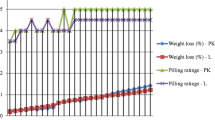Abstract
Twenty-nine cellulase preparations from different sources were compared interms of their abrasive activities (the ability to remove Indigo from denim) and their ability tosaccharify cellulose. Nodirectrelationship could be found between these two abilities. The preparations were divided into three groups: (1) with a high yield of reducing sugars after 24 h hydrolysis of Avicel cellulose but low abrasive activity; (2) universal cellulases that could both effectively hydrolyze cellulose and remove Indigo from denim; and (3) cellulase samples with high abrasive activity but low saccharification ability.
Cellobiohydrolase (CBH) and xylanase were purified from different fungi by chromatofocusing on a Mono P column and subjected to limited proteolysis with papain yielding cellulose-binding and core (catalytic) domains. The adsorption ability and backstaining index of both CBH and xylanase core proteins were notably lower than the respective parameters for the in itial nondigested enzymes indicating that protein adsorption on the surface of cotton fibers is a crucial factor causing Indigo backstaining during the enzymatic denim washing procedure.
Similar content being viewed by others
References
Godfrev, T. (1996), in Industrial Enzymology, 2nd ed., (Godfrey, T. and West, S., eds.), MacMillan, London, pp. 359–372.
Krichevski, G. E. (1997), Textile Chemistry (Moscow, Russia) No. 1(10), 14–34.
Klahorst, S., Kumar, A., and Mullins, M. M. (1994), Textile Chemist and Colorist 26, 13–18.
Koo, H., Ueda, M., Wakida, T., Yoshimura, Y., and Igarashi, T. (1994), Textile Res. J. 64, 70–74.
Kumar, A., Yoon, M.-Y., and Purtell, C. (1997), Textile Chemist and Colorist 29, 37–42.
Cavaco-Paulo, A., Morgado, J., Almeida, L., and Kilburn, D. (1998), Textile Res. J. 68, 398–401.
Gusakov, A. V., Sinitsyn, A. P., Berlin, A. G., Popova, N. N., Markov, A. V., Okunev, O. N., Tikhomirov, D. F., and Emalfarb, M. (1998), Appl. Biochem. Biotechnol 75, 279–293.
Ghose, T. K. (1987), Pure Appl. Chem. 59, 257–268.
Sinitsyn, A. P., Chernoglazov, V. M., and Gusakov, A. V. (1990), Methods of Investigation and Properties of Cellulolytic Enzymes, Biotechnology Series, vol. 25, VINITI Press, Moscow, Russia.
Wood, T. M. and Bhat, K. M. (1988), Methods Enzymol. 160, 87–112.
Van Tilbeurgh, H., Tomme P., Claeyssens, M., Bhikhabhai, R., and Pettersson, G. (1986), FEBS Lett. 204, 223–227.
Author information
Authors and Affiliations
Corresponding author
Rights and permissions
About this article
Cite this article
Gusakov, A.V., Berlin, A.G., Popova, N.N. et al. A comparative study of different cellulase preparations in the enzymatic treatment of cotton fabrics. Appl Biochem Biotechnol 88, 119–126 (2000). https://doi.org/10.1385/ABAB:88:1-3:119
Issue Date:
DOI: https://doi.org/10.1385/ABAB:88:1-3:119




